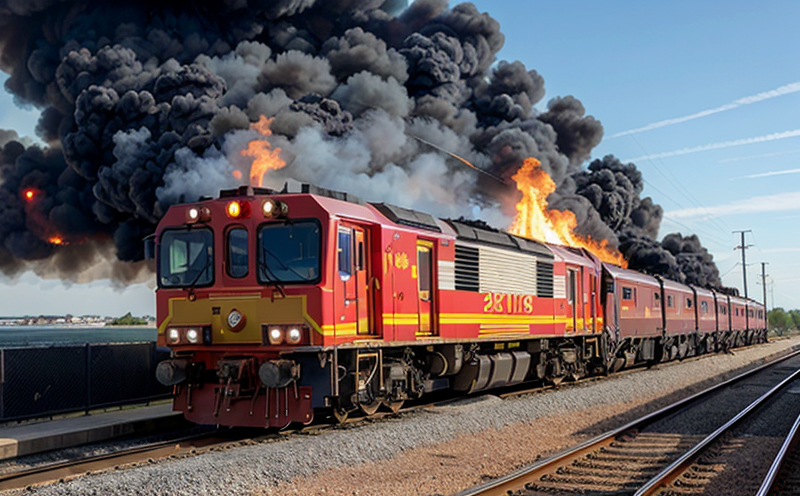Reaction-to-Fire Testing of Marine Emergency Exits
The Reaction-to-Fire (RFT) testing of marine emergency exits is a critical procedure that ensures compliance with international maritime safety regulations. This testing evaluates the materials and design of exit components to ensure they can withstand fire without compromising passenger safety. In this process, specimens are exposed to controlled fire conditions to observe their behavior under extreme temperatures.
The testing methodology involves several key steps: specimen preparation, sample exposure to specific fire parameters, observation of material response, and detailed documentation of results. The primary goal is to determine the time it takes for a flame or smoke barrier to fail, as well as any structural integrity loss that could impact emergency evacuation.
The testing apparatus typically includes an RFT chamber capable of simulating real-world fire scenarios. This chamber ensures uniform exposure and controlled conditions, which are essential for accurate results. The specimens tested range from door frames to entire exit assemblies, depending on the client's requirements.
Upon completion of the test, a detailed report is generated that includes both quantitative data (such as time-to-failure) and qualitative observations (such as structural changes). This information is crucial for design modifications and compliance with relevant standards such as ISO 1716:2019 and EN 354-2.
The importance of this testing cannot be overstated. Non-compliance can lead to significant safety risks, not only during emergencies but also during routine operations. Therefore, ensuring the integrity and performance of these critical exit components is paramount.
Understanding the specifics of Reaction-to-Fire Testing helps stakeholders appreciate the nuances involved. From selecting appropriate specimens for testing to interpreting results accurately, every step plays a vital role in achieving compliance and enhancing safety standards.
Why It Matters
The importance of Reaction-to-Fire Testing cannot be overstated, especially within the context of marine emergency exits. These components are designed to ensure safe passage during emergencies and must withstand harsh environmental conditions, including fire. The testing process helps manufacturers identify potential weaknesses in their designs early on, allowing for necessary modifications before products reach market.
From a regulatory standpoint, compliance with standards like ISO 1716:2019 ensures that all involved parties meet the highest safety benchmarks set by international maritime organizations. This alignment not only protects passengers but also supports the broader goal of reducing accidents and fatalities at sea.
In practical terms, successful RFT testing can lead to improved product reliability and increased confidence among end-users. For example, knowing that an exit assembly has been rigorously tested under controlled conditions provides peace of mind for both manufacturers and operators. Additionally, such testing supports continuous improvement in design and materials science.
The long-term benefits extend beyond immediate compliance requirements. By investing in robust RFT protocols now, companies can position themselves as leaders in safety innovation within the maritime industry. This commitment to excellence fosters trust among clients and enhances brand reputation globally.
Industry Applications
| Application Category | Description |
|---|---|
| Marine Emergency Exits | This includes the evaluation of door frames, hinges, and overall assembly to ensure they meet stringent fire resistance requirements. |
| Railway Safety Products | Testing materials used in railway carriages or station exits for their ability to resist ignition and spread of flames. |
| Airport Security Entrances | Evaluating the fire resistance capabilities of access points designed to protect against unauthorized entry during emergencies. |
The application of Reaction-to-Fire Testing is not limited to marine environments. It also applies to railway systems and airport facilities, ensuring that all critical safety measures are met across different sectors. This versatility underscores the universal importance of robust fire safety protocols.
Why Choose This Test
Selecting Reaction-to-Fire Testing for marine emergency exits is a strategic decision that offers numerous advantages. Firstly, it ensures compliance with international maritime standards such as ISO 1716:2019 and EN 354-2, which are crucial for regulatory approval.
Secondly, the test provides valuable insights into material performance under fire conditions. By identifying potential weaknesses early in development, manufacturers can implement corrective actions before production begins, reducing costs associated with rework or recalls.
Moreover, successful RFT testing enhances brand reputation by demonstrating a commitment to safety and quality assurance. This transparency builds trust among stakeholders, including customers, regulators, and industry peers.
The process also supports innovation in materials science and design engineering. Continuous improvement through rigorous testing encourages manufacturers to explore new solutions that not only meet current standards but anticipate future challenges.
In summary, Reaction-to-Fire Testing is essential for ensuring the safety and reliability of marine emergency exits. It offers a comprehensive approach to quality control while fostering an environment conducive to long-term success in the maritime industry.





